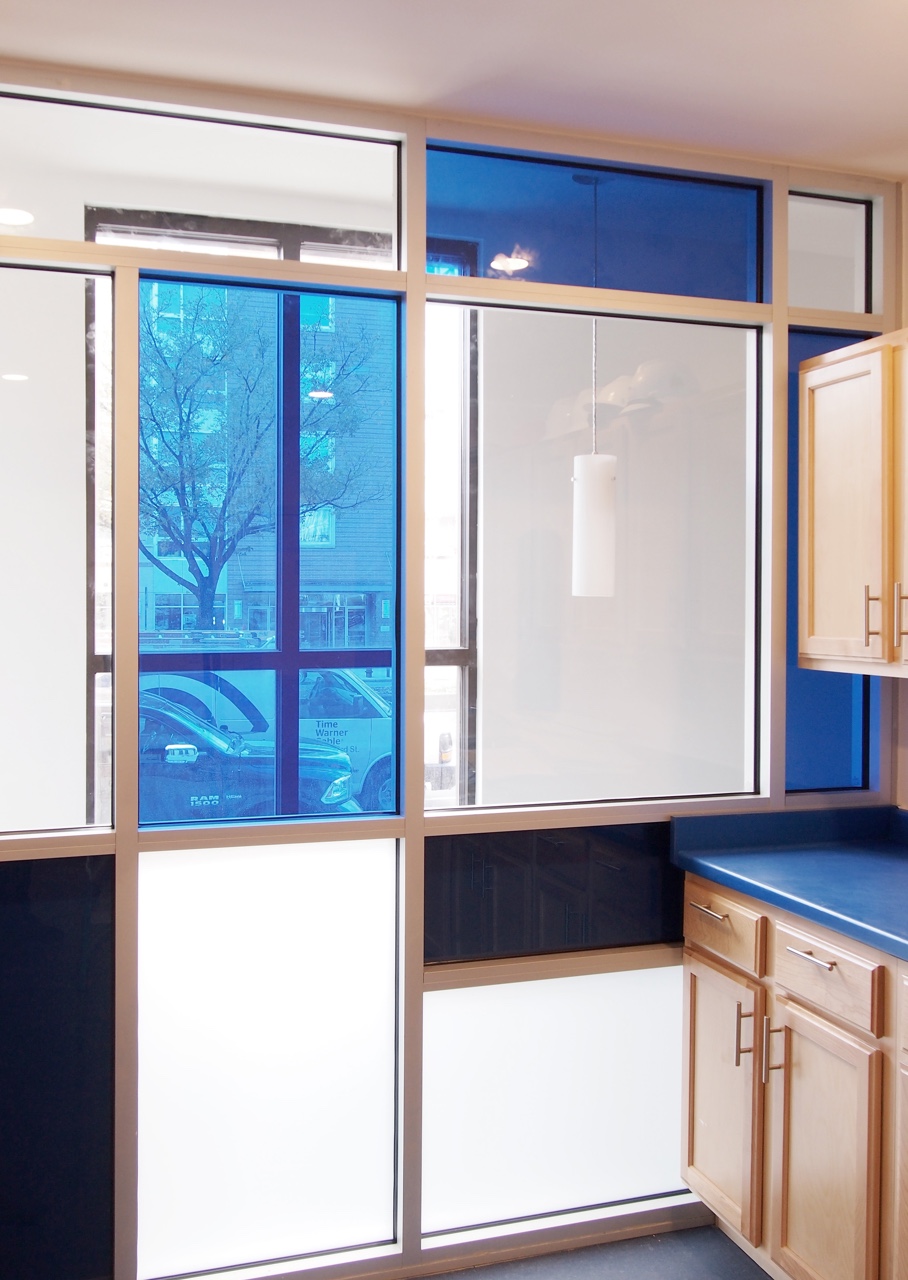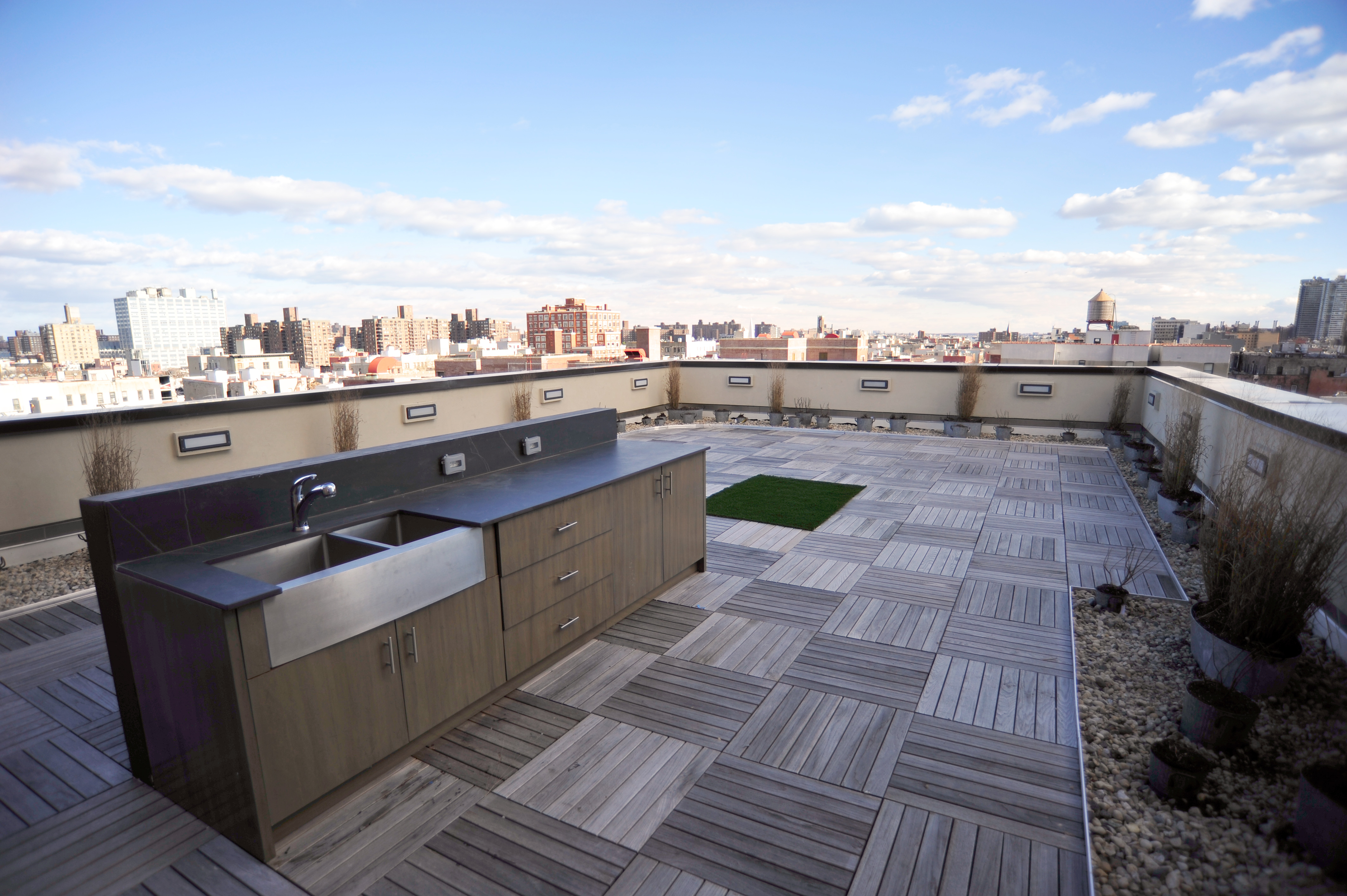A Home for Harlem Dowling is much more than a home. Of its 60 affordable housing units, 12 studios are specifically dedicated for young adults aging out of the foster care system. Here, residents have a cohesive and restorative living space with direct access to the education, employment, and mentoring services they’ll need to help them move from institution to independence. These services are central to the work of Children’s Village (CV) and The Harlem Dowling-Westside Center (HD), two foster care organizations housed on the lower floors of the building. Above those, on the upper floors, are 48 more affordable housing units.
“I have my own apartment now, I make my own decisions, and I feel good about myself ... I feel like I am a part of a community,” says Robert Ramaseur as he walks through his new apartment in Harlem, NY. Robert is one of twelve young adults who live in the affordable apartment units atop A Home for Harlem Dowling.
The mixed-use project was designed by Urban Quotient (UQ), a firm committed to equitable built environments and developed by both Children's Village and Alembic Community Development. UQ’s principal, Samir S. Shah, saw this project as directly in line with their mission and sought a collaboration with Children’s Village and The Harlem Dowling-Westside Center to bring all three elements of the project under one roof. The result is a safe, multi-use space for these young adults, where they can get a solid footing as they transition to life outside foster care.
According to the National Foster Youth Institute, “Twenty percent of the children who were in foster care will become instantly homeless after reaching the age of 18. And only one out of every two foster kids who age out of the system will have some form of gainful employment by the age of 24.” In NYC alone, 7,804 kids were in the foster care system daily in 2019, and, as of March 2020, there were a total of 21,000 homeless children citywide.
When designing the building, Urban Quotient placed those twelve studio apartments on the top floors, subverting traditional real estate models in New York City.

When designing the building, Urban Quotient placed those twelve studio apartments on the top floors, subverting traditional real estate models in New York City. Typically, these penthouse-style apartments with impressive views, floor-to-ceiling windows, and modern design sensibilities, are reserved for the wealthiest residents. Instead, UQ wanted to provide this space for the lesser privileged young people who would be living at Harlem Dowling. Shah wanted to “turn the return on investment model on its head. The youth aging out of foster care are the investment. We are giving something that usually has the most value to those who have had the least opportunity.” He recalls thinking during the design process: “Let’s give the kids the penthouse. Not only do they deserve all this, a lot is available to them. The message is: ‘Look out these windows. The city is yours. Go get it!’”
A Design That Gives Back
The Home for Harlem Dowling building sits on the corner of Adam Clayton Powell Boulevard and West 127th Street, blocks away from the Apollo Theater, the Hotel Theresa, and Abyssinian Baptist Church – right in the heart of Harlem. Throughout the 20th century, Harlem was the epicenter of much of Black American history, from the Great Migration to the Harlem Renaissance to the Civil Rights movement.
In the last fifteen to twenty years, Harlem has seen displacement of long-time community members and rapid gentrification, as has much of New York City. The Harlem Dowling plot was one of the last undeveloped prime, city-owned parcels in the neighborhood. When the city awarded Harlem Downing the land, the organization was given a unique opportunity to draw upon its history by creating a new home, further root itself in the community through long-term ownership, and invest in the young people it has always served.
Harlem Dowling is one of the oldest Black American organizations in the United States. Given this confluence of history surrounding the project, Shah believes he had “… an obligation to give significance and substance to the design that matched the importance of the site and the cultural significance of the neighborhood.”
The building's facade has a syncopated double facade that alludes to Harlem’s rich cultural and musical history while bringing even more light to the building. The street-level, outer facade pays tribute to the traditional NYC residential brownstone architecture. The interior facade, with alternating window sizes and colors, creates movement with the exterior and draws light and attention to the program happening inside the building. Shah points out, “There is a certain amount of jazz in the facade. The street-level facade is the primary rhythm, tying our building to something well known in the NYC residential landscape. The inside plays a secondary rhythm, which creates that syncopation. Harlem and the Harlem Dowling program create that surprising secondary rhythm in NYC.”

The brick that covers some of the building also connects to traditions in the neighborhood, while the red and yellow metal sheeting covering other parts celebrate the vibrancy of the program happening on the inside. “It was important that we showed an understanding of the history of elegant residential architecture that is all over the neighborhood,” says Shah, “to send a message of respectability, and to live up to the specific cultural legacy of Harlem.”
A Collaboration for Efficiency and Equity
Today, Children’s Village and Harlem Dowling continue to provide services and housing to children, especially children of color, in the foster care system. As Jeremy Kohomban, CEO of Children’s Village and President of Harlem Dowling, puts it, “The kids (Children’s Village) serves are almost exclusively poor. Kids who are the least valued. And over the last hundred years that population has disproportionately been Black children.” The Administration for Children and Families Services reports that more than half of the children living in foster care in 2019 were children of color. Kohomban, who came to Children’s Village in 2004, is responsible for the revamping of its Dobbs Ferry campus and much of its work at Harlem Dowling. He has pushed to move away from the historically institutional model of foster care, to: “provide a place where...kids who have had bad things happen to them...can grow, find the support they need to get back to their families, a place of unconditional belonging until we can get them back to people who love them.”
Led by Shah, UQ has been employing architecture as a tool for social advocacy for over a decade, focusing on serving community development organizations and nonprofit clients. UQ specializes in complex mixed-use projects that often combine affordable or supportive housing with cultural or community facilities. Shah credits this focus and commitment to rigorous design for UQ’s selection as the firm for the Harlem Dowling project.
UQ has been employing architecture as a tool for social advocacy for over a decade, focusing on serving community development organizations and nonprofit clients.
Urban Quotient and Children’s Village consider their collaboration on the Harlem Dowling project to be a tremendous success that has led to their developing a close working relationship. UQ designed a building that Kohomban felt completely captured the values of CV and HD. The Home for Harlem Dowling project moves away from institutional architecture and preconceived biases about the people Children’s Village serves, instead toward making something beautiful. Shah summarizes this process by saying, “There was an alchemy involved in this project; in order to match what we drew up and conceived on paper with what would be built, we had to have more than intent – we needed the right foundation of values to align across all members of the team. Those values needed to make it into the final product. You can have all the time and money, but those values don’t always translate. Everyone involved with Harlem Dowling was on board, so the values carried our intentions through to the finished building.”
At the ribbon-cutting ceremony for the building, Kohomban introduced Shah to two young tenants of the studios, Miranda Lebron and Robert Ramaseur. These kinds of ceremonies are usually photo-ops with elected officials and investors; instead, Kohomban took the opportunity to thank Shah and Urban Quotient and also to connect him with people directly benefiting from the project. Shah describes, “As an architect, you rarely have the opportunity to meet the people your work directly affects. That was a really special moment and one that exemplified the importance of Harlem Dowling.”
During the post-ribbon cutting tour, Kohomban was particularly proud to show off the outdoor terrace and kitchen on the ninth floor, a feature of the building he personally fought for. Like the penthouse style studios, the population of young foster children of color that CV serves does not normally have access to terraces, or much outdoor space at all. Kohomban knew that the terrace would be an essential part in community building at HD, providing a space for gathering and bonding that is both safe and restorative. The organization holds meetings, celebrates graduations for kids that have completed both their education or time in the program, and generally comes together on this terrace. Gathering in a serene space to eat food and celebrate is just as important as the housing and counseling services at CV; Kohomban says: “It is an easy way to build bridges. It is an easy way to get beyond the cultural and racial separations that have been imposed on us.”

The access to safe outdoor space that the terrace provides has been even more crucial during the COVID-19 pandemic. When the kids who live in Harlem Dowling were restricted to staying indoors, the terrace provided much needed outdoor access. Kohomban ran into two young people at HD during the quarantine, who told him that they went outside on the terrace every day and have been using the space as a much needed breath of fresh air. “They said to me, ‘If we didn’t have that terrace,’” Kohomban recalls, “‘we would have gone crazy.’ To have that access, they don’t have to be out on the street, maybe running the risk of being stopped by the NYPD. It’s an absolute game changer.”
Envisioning the future of Children’s Village, Kohomban believes that the organization will continue to serve its current populations, while fighting social inequalities to try to ease and even end the requirement for that help. “It’s about giving people what they need,” he says, “Beyond reacting to emergencies and injustices, we want to create a new history around social injustice.”
Both Shah and Kohomban describe a synergy and an implicit understanding between Urban Quotient and Children’s Village. There is a sense of trust between the two organizations. Their work together shows what is possible when an architecture firm and an organization like CV have a symbiotic relationship. “It is a real joy when our values come together,” says Kohomban, “...duty is so embedded in our collective consciousness that even good people can come up with institutional designs...it takes a lot of time to find someone who shares your values and your joy about doing something a certain way. And Urban Quotient and Children’s Village share that.”